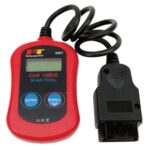Encountering a trouble code in your Dodge vehicle can be unsettling, especially when it points to potential engine issues. Among these, the Obdii Dodge P1217 code signals a specific problem: the engine control module (ECM) has detected an engine over temperature condition. While your initial reaction might be alarm, indicating a severely overheating engine, it’s crucial to understand the nuances of this code before jumping to conclusions.
The P1217 code is a manufacturer-specific diagnostic trouble code, meaning it’s defined by the vehicle manufacturer, in this case, Dodge. It’s triggered when the ECM perceives that the engine’s temperature is exceeding the normal operating range. However, it’s important to note that this perception can sometimes be misleading. The issue might not always be actual overheating, but rather a problem with the sensor that measures engine temperature or the system that cools the engine.
Several factors can lead to a P1217 code in your Dodge. A primary suspect is the engine coolant temperature (ECT) sensor. If this sensor is faulty or its circuit has issues, it could send inaccurate high-temperature readings to the ECM, even if the engine is running at a normal temperature. Therefore, diagnosing a P1217 often starts with checking the ECT sensor’s readings using an OBDII scan tool. A drastically high reading, like 400 degrees Fahrenheit when the engine doesn’t seem hot, strongly suggests a sensor or circuit problem.
Beyond sensor malfunctions, genuine cooling system problems can also trigger the P1217 code. These can range from simple issues like low coolant levels or air pockets in the system – often occurring after recent coolant service – to more complex mechanical failures. A malfunctioning cooling fan, whether it’s a crank-driven fan with a faulty clutch or an electric fan failing to operate, can impede cooling and cause overheating. Similarly, a stuck closed thermostat, a failing water pump, or issues with the radiator itself, such as a blockage or a faulty radiator cap, can all contribute to the engine running hotter than it should.
When faced with a P1217 code, a systematic approach to diagnosis is key. Start by verifying if the engine is truly overheating. While the dashboard temperature gauge can offer some indication, using an infrared thermometer to check the actual engine temperature can provide more reliable data. If you suspect the ECT sensor, using a scan tool to monitor the sensor’s readings is the next logical step. Visual inspection of the cooling system components, checking for leaks, coolant levels, and fan operation, is also crucial.
In conclusion, the OBDII Dodge P1217 code points to an engine over temperature condition, but it doesn’t always mean your engine is actually overheating. Troubleshooting should involve checking the ECT sensor and thoroughly inspecting the entire cooling system for potential faults. Addressing the root cause promptly is essential to prevent potential engine damage and ensure your Dodge operates reliably. If you’re unsure about diagnosing or repairing the issue, consulting a qualified mechanic is always recommended.

